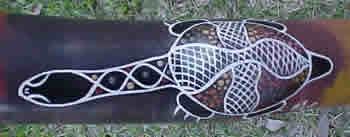| Didgeridoo Care and Repair |
|
This page is a reference for owners of didgeridoos purchased from 'The Didgeridoo Specialist' or didjshop.com. Information given on this page may not be applicable to didgeridoos from other vendors. General Didgeridoo Maintenance Your didgeridoo is a wooden instrument. To be able to appreciate it for many years, we advise you to take the following care:
For cleaning your didj we advise using soapy water unless you have an ochre didj, in which case we do not advise to use any liquid on your didj. If you do have an ochre didj we advise you minimise the handling and/or wear gloves when handling it, since the sweat from your hands over time might affect the fragile ochre colours. Our ochre didgeridoos have several layers of artists fixative to minimise this effect, but they are not as well protected as our other didgeridoos. The mouthpiece of your didgeridoo will require constant maintenance, depending on how much you play your didgeridoo. It's shape will also have a large effect on your ability to play the didgeridoo So we recommend that you learn to form a good mouthpiece. Before you take the mouthpiece off your didj, learn on something else. Any length of 40 or 50 mm pipe will do. Or you can use an old cup or glass. Take the extra piece of beeswax we sent you with your didgeridoo and take it out of the plastic bag (You can also get yourself some beeswax from Hardware shops, Arts and Crafts shops or Health Food shops). Place the beeswax in a closed glass jar in full sun for half an hour or into the oven at very low heat (~60C° or 135F°) or place it in the microwave for 10 seconds. It should be soft and very easily pliable just like play dough or pottery clay. If the beeswax gets too hot it will become crumbly and unworkable. If that happens allow it to cool enough to be pliable again. Now take the strip of beeswax (if you have a block it will be very easy to cut a strip off. The strip should be about 130 to 150 mm long (5"-6") and about 7-15 mm thick(1/4"-3/4") depending on the top diameter of your didgeridoo) and start pressing one end onto the inside edge of the didgeridoo (or pipe or cup). Keep pressing the strip onto the inside edge of the didgeridoo until you complete the circle. While doing this, envisage the size of the final hole you want to end up with (about 33-40 mm across). Discard any extra beeswax you might have and join the ends of the beeswax. Now work around the mouthpiece pressing the beeswax firmly onto the top surface of the didgeridoo, keeping an eye on getting an even circle and that the wax tapers out nicely and does not get too thin on the top surface of the didgeridoo. On the next round seal the beeswax firmly against the inside of the didgeridoo, letting it taper out evenly into the didgeridoo. Then adjust the heights level of the mouthpiece and the inside diameter. You want to form a fairly sharp edge which allows your lips to vibrate freely, rather than a rounded edge which will make that harder. You also want to make sure that the inside edge of the mouthpiece is evenly round and evenly high. Any unevenness will make it harder to seal your lips onto the mouth piece. The best size of the mouthpiece depends on your mouth and we advise you change the shape and size of your mouthpiece until you find it easiest to play. The size and shape of the mouthpiece can make a big difference to the ease of playing or even the ability to get the base sound. So please learn to play around with the beeswax mouth piece. See also making a beeswax mouthpiece for your didgeridoo - an illustrated guide The inside of our didgeridoos is well sealed and does not need any further sealing, nor do we advise to pour any water or oil through it. Some people advise to pour oil through your didj every few month, but we do not advise to do so if your didj has any non-oil finish or artwork on it. The oil tends to slowly seep through the wood and lift the paint or artwork off. This might take several years, but will be a messy affair once it starts... So please do not pour any oil through our didgeridoos. Other people swear by pouring water through their didgeridoo before playing to improve the sound. This is true for didgeridoos which are unsealed on the inside. The effect is achieved by the water forming a skin over the slightly rough surface of the wood. Frequently pouring water through your didj may accelerate or cause cracking. Each one of our didgeridoos is sealed all the way through the inside. This creates a very smooth surface facilitating good sound quality. It also seals the whole inside of the didgeridoo and thus helps to prevent cracking and splitting. So if you are the proud owner of a didjshop.com didgeridoo you do not have to do anything to the inside of your didgeridoo. Possible long term maintenance If you use your didgeridoo frequently, it might develop some wear and tear around the bottom edge from abrasive contact with the ground. We advise that you get a non-yellowing varnish to cover up any exposed wood if you experience this type of wear with your didj. We use a high quality non-yellowing water based varnish on most of our didjes (main exceptions are ochre didjes and Brad's didjes). Any good quality varnish will bind to it.
|
|
Home | About Us | Checkout | Community | Help | Information | Shopping Didj Forum | Send a Didj Greeting Card | Guest Book |
| © Didjshop.com, 1993-. For rights reserved and granted see our Copyright notice. |



 Related links
Related links